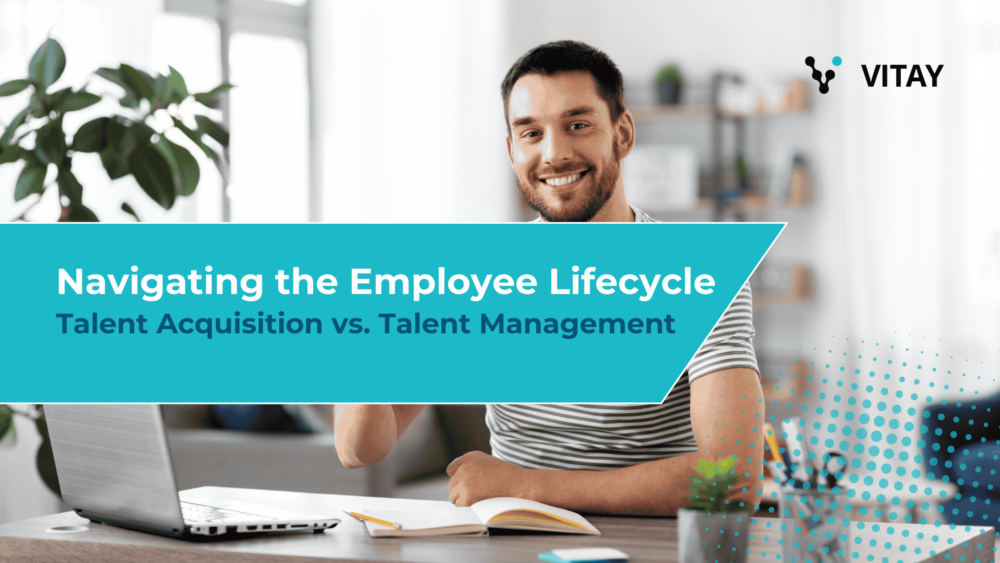The competition for top talent is stronger than ever. Understanding the difference between talent acquisition and management is crucial in such an intense landscape. Understanding how the two concepts can work together for stronger teams is just as important.
Organizations aiming to foster a skilled and committed workforce need to understand both practices. While each area is vital for human resource (HR) success, they serve different purposes and require unique strategies. This article explains what savvy hiring managers need to know about acquiring and developing top teams.
Key Differences Between Talent Acquisition and Talent Management
Generally speaking, talent acquisition refers to attracting, recruiting, and hiring individuals for specific job roles. Talent management encompasses a broader strategy, including developing, retaining, and optimizing a workforce. Talent acquisition focuses on bringing new talent into the organization, while talent management maximizes existing employees’ potential.
These different functions manifest in several specific ways. Here are some other notable differences between talent acquisition and talent management.
Timeframes
Talent acquisition addresses the immediate need for hiring. It involves identifying, attracting, and selecting candidates to fill specific job vacancies and current hiring needs.
On the other hand, talent management has a longer-term perspective. It is centered on developing and optimizing an organization’s talent pool, including training, performance management, succession planning, and employee engagement strategies. Talent management includes contributing to the employee’s career growth and aligning with the company’s goals.
The Roles of HR
Human Resources (HR) plays distinct roles in both areas. In talent acquisition, HR professionals act as recruiters, strategists, and brand ambassadors. They are responsible for crafting compelling job descriptions, leveraging social media, and conducting interviews to attract top talent.
In talent management, HR’s role shifts towards being a facilitator and coach. HR professionals design training programs, implement performance reviews, and foster a culture of feedback. They are also responsible for creating pathways for career advancement and ensuring that employees feel valued and engaged.
Technology and Data
Technology is helpful in talent acquisition and management, but in different ways. Talent acquisition utilizes applicant tracking systems (ATS), recruitment marketing tools, and data analytics to streamline the hiring process and enhance a candidate’s experience.
Talent management is more likely to rely on performance management systems, learning management systems (LMS), and employee engagement platforms to track employee development, assess performance, and gather feedback.
As with many parts of business, both areas benefit from data analytics. However, the metrics they focus on and the insights derived from the data can differ greatly.
Culture and Employee Experience
An organization’s culture significantly impacts both talent acquisition and talent management. When acquiring talent, having a strong employer brand and positive candidate experience is essential for being competitive. Companies that prioritize diversity, equity, and inclusion tend to have the advantage in attracting candidates.
Talent management is part of building that culture. Here, the business must support continuous learning, collaboration, and employee well-being. Organizations that invest in creating a positive employee experience are more likely to retain their talent and foster loyalty.
Opportunities for Synergy Between Talent Acquisition and Talent Management
While talent acquisition and talent management serve different purposes, there are ample opportunities for synergy between the two. Aligning hiring strategies with long-term talent management goals will create a more cohesive workforce.
For instance, talent acquisition can focus on hiring candidates who not only meet current job requirements but also have the potential for future leadership roles. Similarly, talent management can provide valuable feedback to talent acquisition teams about the skills and competencies that are essential for success in specific roles, ensuring that future hiring aligns with the organization’s strategic direction.
Here are some other specific tactics that HR professionals can utilize to enhance and act on this synergy:
Create a Shared Competency Framework
HR professionals can develop something called a unified competency framework that outlines the skills, behaviors, and attributes necessary for success across various roles. By ensuring that both talent acquisition and talent management are guided by this framework, organizations can hire candidates who not only fit the current job requirements but also possess the potential for future roles.
Focus on Collaborative Onboarding Programs
Designing a comprehensive onboarding program that involves both talent acquisition and talent management can enhance the new hire experience. Talent acquisition can provide insights into the expectations set during the recruitment process, while talent management can focus on integrating new employees into the company culture and providing initial training. This collaboration ensures that new hires feel welcomed and supported from day one, which can lead to higher retention rates.
Feedback Loops
Establishing feedback loops between talent acquisition and talent management is crucial for continuous improvement. Talent acquisition teams can gather insights from talent management about the performance of new hires, which can inform future recruiting strategies.
Talent management can provide talent acquisition with data on the skills that have been successful within the organization, allowing recruiters to better target their candidate searches.
Joint Talent Reviews
Conducting joint talent reviews involving both talent acquisition and talent management teams can identify high-potential employees who may be ready for advancement. This collaborative approach allows HR professionals to spot internal candidates who are suitable for future roles and align their development plans with hiring strategies, ensuring a pipeline of qualified candidates for leadership positions.
Leverage Data-Driven Insights
HR professionals can leverage data analytics to bridge the gap between talent acquisition and talent management. By analyzing recruitment metrics (such as time-to-fill, candidate quality, and turnover rates) alongside performance management data, organizations can identify trends and make informed decisions. This is a great way to allow for more strategic hiring that aligns with the organization’s overall talent goals.
Cross-Functional Training
Implementing cross-functional training sessions between talent acquisition and talent management teams can foster a deeper understanding of each function’s challenges and objectives. Such training encourages collaboration and enables both teams to work more effectively together, leading to better alignment in strategies and initiatives.
By implementing these tactics, HR professionals can create a powerful synergy between talent acquisition and talent management, ultimately leading to a more engaged, skilled, and loyal workforce.
While talent acquisition and talent management are distinct yet interconnected functions, their synergy is vital for building a robust workforce. By understanding the difference between talent acquisition and talent management, HR leaders can leverage




Comments are closed.